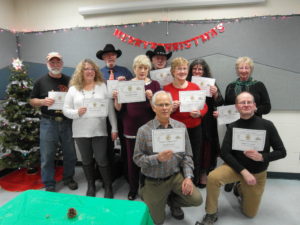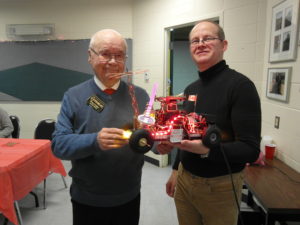- Home
- Registration
- Site Tools
- Articles
- Swap n Shop
- Contesting
- Grounding information for everyone
- History of the Central Alberta Amateur Radio Club
- CAARC owned Repeaters
- Club Repeater Info
- GMT Time Conversion Table
- VE/VA6 Incoming QSL Bureau
- Pine Lake Tornado Friday July 14, 2000.
- Amateur Radio to the Rescue
- CANWARN
- HAM Nation with Bob Heil K9EID
- Net info
- Events.
- ARES
- Links and On line study course.
- Field Day 2019
- Members D/L
- Forum/Swap and Shop
ARES
ARES call outs or on air exersises
ARES Net Control Volunteers
Aug 20th
Firstly, I acknowledge the contribution made by Greg VA6GMC as ARES Net Control; thank you Greg.
ARES Red Deer is seeking volunteers to take on Net Control duties for the Sunday evening ARES Net. If you’re new to ARES, this is a good opportunity to learn or improve your net control and traffic handling skills.
There is a script to follow, and, in general, the Net doesn’t take more than 15 to 20 minutes. If you are able to commit to operating Net Control once every five weeks, I’d like to here from you.
Once there is at least five volunteers, a schedule will be drawn up with volunteers operating in rotation.
If you’re interested and would like to know more drop me a line at stephen dot lee@shaw dot ca, or give me a call at four zero three-three zero seven-1643.
If you’re already an ARES member that’s awesome, it not, why not sign up; just ask for details.
73
Steve VA6SGL CEC
CAARC and Red Deer & Area EC

CAARC Members receive awards for volunteering during the last year.
Dec 20th
CAARC Members receive awards for volunteering during the last year. Congratulations to the members who received Volunteer Service and Volunteer Service with Excellence awards.
Congratulations to Doug VE6DJC on winning the GIZMO! We look forward to seeing what he adds to it for next year’s Christmas dinner!
New volunteer net control operator
Apr 19th
We have a new volunteer for the Monday evening net controller.
Thanks to Maria VA6TFL for your willingness to help with the net.
Any other volunteers would be welcomed to add to the list.
Thanks to the five other net controllers for taking your turn.
Please check Updated Net Controller List under the Net info TAB
73
Bob VE6BLD
CAARC Net Controller Co-ordinator
Canwarn Training
Mar 24th
CANWARN, acronym for CANadian Weather Amateur Radio Network
Please note that CANWARN is not about storm chasing, it is about putting trained eyes at the local level to confirm what is happening under severe weather and communicating that information to the Meteorological Service of Canada.Here’s how CANWARN works in Central Alberta. When the regional weather forecast office (for the prairies this is the Prairie Storm Prediction Centre in Winnipeg, MB) would like to get ground observations of potentially severe thunderstorms they telephone the CANWARN person whom they have listed as the call-out person for the area of interest. In Central Alberta this will be the same people that are listed as ARES emergency coordinators. All Central Alberta and Olds ARES EC’s are trained CANWARN network controllers. The mechanics of how the net operates, local hams are notified and how their weather reports are forwarded to the forecast office are up to the CANWARN net controller. CANWARN Net Control may relay the observations or may elect to use a phone  to put the forecasters and amateur observer in direct contact.Typically, the person contacted by the Meteorological Service of Canada notifies the affected-area CANWARN hams who then radio their weather reports to their CANWARN Net Control Net. Net control then forwards the weather observations to the weather forecast office on a dedicated 1-800 phone number. As the storm moves along, reports would hopefully still come in from either stationary or mobile spotters allowing weather forecasters to continually compare the Carvel and Strathmore Doppler radar to what is being observed at ground level (below the radar horizon) and adjust their weather forecasts, Watches and Warnings accordingly.
Amateur Radio Saves the day again
Sep 22nd
Last night, Sunday September 21, 2014, at approx. 21:00hrs PST VY1MAP (Terry) called on our local repeater-146.880-looking for VY1RF (Ray).
Terry wanted Ray to make a phone call for him as he was not in cell phone range. The situation was that Terry is a member of our Search and Rescue team and they were on a search for a missing teenager. The command center they had setup was approx 35kms north of Whitehorse at Lake Laberge. The satellite phone that they were to use, was not functioning so they had no way to call for assistance, additional resources or send status reports.
That’s where amateur radio comes in. Terry, being a ham, goes out to his truck and makes contact with Whitehorse via 2M amateur radio with VY1RF (Ray) and VY1RM (Ron). They were able to pass important traffic to/from the command center.
The young man was found and all ended well.
This is the second time in as many months that amateur radio and in particular Yukon Amateur Radio Association’s members and infrastructure proved invaluable in an emergency situation. Good job guys!
Just remember-Keep calm and grab your radio!
RAC ARES
Jun 17th
RAC/ARES meets in Red Deer Alberta
RAC/ARES members took advantage of the recent Central Alberta Amateur Radio Club Hamfest in Red Deer Alberta to meet and discuss issues ranging from recruitment training and organization.
Alberta ARES has had a busy period providing communication services to their communities with the recent floods in Calgary and High River and the Slave Lake fires as only two examples.
Left to right… Neal Sunderland VE6NL the new Section Emergency Coordinator for Alberta, often seen driving around the province visiting members in his Holiday Rambler Class A RV, Jeff Low VA6JL Red Deer Emergency Coordinator and veteran of the recent floods as well as Garry Jacobs VE6CIA Alberta Section Manager. Inset, Ian Burgess VA6EMS Emergency Coordinator for Calgary. [1]
Geoff Bawden, VE4BAW
Acting CFSO and President RAC
Acting CFSO and President RAC
—
[1]Â Web link and photos:Â http://wp.rac.ca/racares-meet-in-red-deer-alberta/
Ham Radio on Fox News
Jun 5th
Why We Are Ham Radio Operators
Apr 8th
Why Amateur Radio is Important
Roger Hunt, K7MEX
A version of this story appeared in the March 2014 edition of All Ears, the newsletter
published by the Escondido Amateur Radio Society (EARS) in California. I spoke with the
primary person involved in this incident, got some corrections to the original version of the
story, and the corrected version appears below.
There is a large off-road 4WD event in the Lake Havasu area held the third weekend of
March each year. Called Desert Run Havasu, it was March 13-16 this year, and involves
4-wheeling runs over trails of varying difficulty. One indvidual who participated this year
was retired attorney Bruce Boogaard, a new ham with the call sign KK6DKJ. Bruce got his
technician license less than a year ago, in April 2103, and admits he has never even been
on a repeater before, using his radios for simplex communication with other 4-wheelers.
Participating in the Desert Run Havasu, Bruce was navigating through an area with a large
group of off-road enthusiasts, and as he had been taught to do, kept his eyes on the
vehicle both in front and behind him. While most of the group used CB radios, Bruce and
another ham named Scott Connelly also kept in touch on a VHF ham frequency. Scott was
near the front of the group, while Bruce was near the rear. The group became widely
separated, with nearly two miles between the first and last vehicles in the group. The
distance proved to be a problem in the difficult terrain and some of the vehicles using CB
radios lost communication. However Bruce and Scott were able to maintain contact with
their ham radios.
Bruce eventually noticed the second vehicle behind him was driving erratically and falling
further behind. When the vehicle made a strange turn up the side of the wash, Bruce
contacted Scott and asked that he relay a message to the group leader by CB radio to stop.
Bruce turned back and checked on the driver, discovering he was incoherent and obviously
having some kind of medical emergency. Bruce updated Scott as to the problem and
stated they needed to get this guy to hospital as soon as possible. There was no cell
service in this remote area, but Bruce had brought with him the frequency and PL tone of
a nearby repeater. Though Bruce had never used a repeater, he was preparing to put the
information into the radio when he received a call on the simplex frequency, 146.550 MHz,
that he had been using to talk to Scott.
As luck would have it, a group of hams belonging to the Family Motor Coach Association
(FMCA) were having an RV ralley in the Lake Havasu area and were using the same
simplex frequency. He heard Bruce’s call to Scott, and since he had cell service where he
was located, offered to call 9-1-1. An ambulance was dispatched to the nearest trail head,
and the 4-wheelers were able to get the man there in about 20-25 minutes. The man was
transferred to the ambulance and later transported via Life Flight to a hospital in Phoenix.
It turned out the man had a blood vessel burst in his brain, but survived, partly because of
the quick action of the amateur radio operators involved. This incident is a classic example
of why ham radio helps save lives, and works when all else fails.
New Brochure for the Central Alberta Amateur Radio Club
May 18th
I have produced a new Brochure for the Central Alberta Amateur Radio Club.
To download a color printable PDF document of the Club Advertising brochure complete with hot links back
to the web site  click this link
or check the second Tab under Site Tools menu.
Bob VE6BLD. Webmaster


